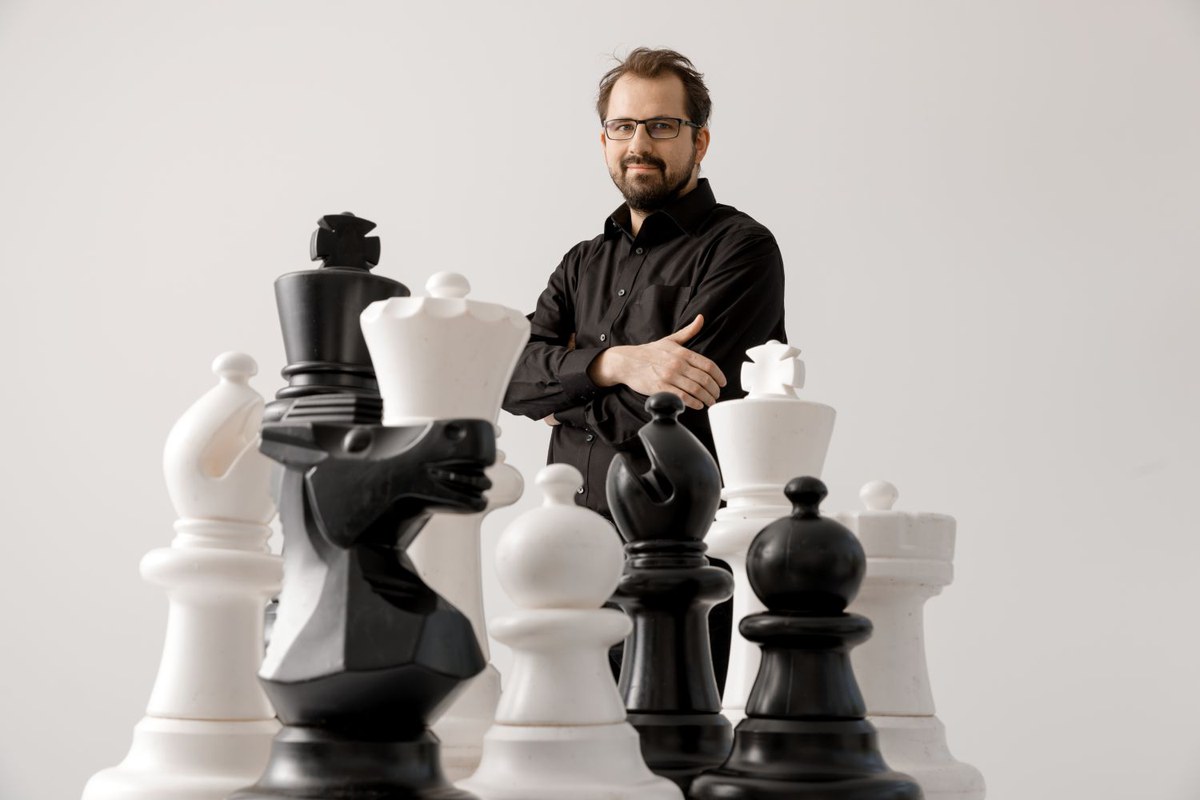Experts are better connected
For the researchers around Robert Langner, chess is more than just a game: they use it in brain research to investigate paradigmatically how the brains of novices and experts differ.
The first driving lesson in heavy traffic: at an intersection without traffic lights, there are four cars looking in different directions, and one cyclist. What the driving instructor sees at a glance causes the learner to break out in sweat. Obviously, the driving instructor is an expert in road traffic matters, the learner an inexperienced beginner. Can you tell by the external reaction alone? That’s not enough for brain researchers. They want to know how different levels of experience are reflected in the brain. An ancient but highly complex game helps them to find this out: chess.

Dr. Robert Langner from the Jülich Institute of Neurosciences and Medicine (INM-7) explains why this particular board game is suitable for brain research: “Chess is based on clearly defined rules that are easy to grasp and has a limited number of pieces. At the same time, however, the game is highly complex, like real life.” In addition, there is an established and objective mathematical method to precisely determine the expertise of a chess player, the socalled Elo score. This rating score makes it possible to establish a direct connection between level of expertise and activity in the brain. A look into the brain, then, reveals clear differences: unlike novices, experienced players use not only one half of the brain, but both. For example, a certain temporal region on the right side is only activated by experts. “We were able to show that this region is efficiently integrated into other brain networks. In this way, relevant information about the game situation and the possible moves of individual objects can be processed and evaluated quickly and comprehensively,” says Langner.
RECOGNIZING PATTERNS AT A GLANCE
How effective this wiring must be in the brain of experienced players can be seen in blitz chess. In fractions of a second, they grasp the situation on the board and make a meaningful move. When comparing the eye movements of experts and beginners in such situations, another difference becomes clear: chess experts focus their gaze only on single, strategically important pieces. Through years of practice and replaying games, they recognize gamespecific patterns and spatial connections on the board and know almost “instinctively” where they have to look to solve a situation. Looking at chess novices, the gaze wanders over a multitude of pieces, even those that have nothing to do with the next move. Functional magnetic resonance imaging showed that areas involved in the recognition of objects and also for spatial connections are activated more strongly in the brains of experienced chess players than in those of novices. “Purposeful perception also plays an important role in everyday situations,” says the psychologist. “For example, the experienced driver recognizes the stop sign and knows that the car coming from the left or right now has right of way, without giving it a long thought.” Skilled visual perception is driven by certain patterns and spatial regularities, both in experienced chess players and in experienced road users. “If the stop sign was placed in a completely unexpected position, it would most likely be overlooked,” says Langner.
Practice makes perfect: If the brain is trained to recognize patterns, even proven experts can sometimes be blocked from seeing something new. In a chess puzzle for advanced players, the psychologist Prof. Merim Bilalić, himself a chess master, placed the pieces in such a way that a checkmate could be achieved with a common five-move strategy. A checkmate in the same situation would just as well be possible with a widely un-known solution in only three moves. If the eyes of the chess players recognized the familiar pattern of the five-moves solution, they concentrated on it and were literally blind to the faster variant. Here, scientists speak of the “set effect”, which can also limit the judgement of other specialists such as lawyers, doctors or personnel specialists. Studies show that radiologists, for example, often concentrate on the first irregularity that catches their eye. At the same time, other signs of a disease may be overlooked, such as swelling, which may indicate a tumor. In the chess experiment, only grandmasters – i.e. experts with enormous experience – were able to recognize the shorter three-move solution to the checkmate.

WHEN ROUTINE IS NOT ENOUGH
Even chess experts can get confused. Experiments carried out by Langner’s colleague Prof. Merim Bilalić at the University of Tübingen have shown that if the chess pieces are spread out on the board without any concept, the eyes of experts meander across the random arrangement as do those of the novices. The situation will be similar even for the most experienced European drivers if they find themselves in the chaos of an Indian crossroads. “ ‘Chaos’, however, is relative,” Langner interjects. “The situation is chaotic only for those who don’t know the local rules.” The observation of chess players could also help to understand how the brain works in other challenges. “In chess, it is not only important to grasp the current game situation and plan the next moves, it is also important that the players put themselves into the opponent’s position,” says the Jülich scientist. For example, he and his colleagues are interested in whether chess is suitable for neuroscientific studies of social phenomena, such as interactions with other people or recognizing the intentions of a counterpart. “To our knowledge, using chess in this context is completely new territory,” says Langner.
Brigitte Stahl-Busse
Institute of Neuroscience and Medicine - Brain and Behaviour (INM-7)
